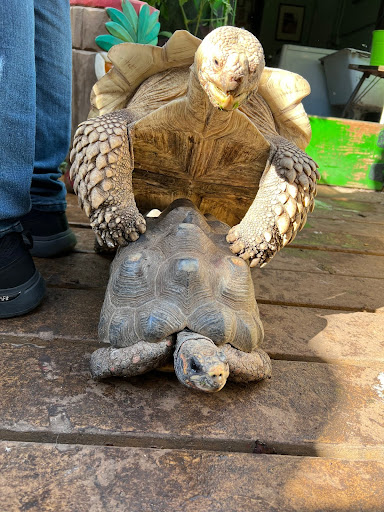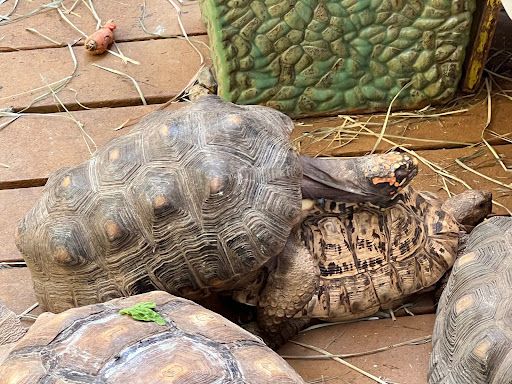Have you ever wondered if two different chelonians (tortoises, turtles, or terrapins) can procreate? Let’s talk about it!
Here at TortoiseLand, we keep all of our different types of tortoises together in a creep! TortoiseLand is a rescue organization that does not control which species show up at any given time. We accept all chelonians into our creep, as it is the best way to house them.
Our most social species, such as the Leopard Tortoise, Redfoot, and Sulcata, like to mingle and attempt to mate with other tortoises and turtles. This is not recommended or initially safe to do under the care of amateurs; behaviors should always be monitored by professionals!
While hybridization is doable between species of similar genus, TortoiseLand does not encourage hybridization, or recommend housing a creep of different tortoise species. If you or anyone you know is housing a hybridized tortoise or turtle, we encourage the caregiver to seek care tips from a reputable reptile specialist.
Despite most tortoise species being solitary, some tortoises do like to “mingle” on a regular basis! Just like dogs, tortoises can get along just fine with other chelonian species. Because of this, they may try to mate with each other!
The majority of our tortoises are healthy enough to freely roam Tortoiseland, so they get to make friends with all of the different species.
Sick tortoises and turtles are kept in special quarantine pens while they heal, giving the other tortoises the green light to socialize! Sometimes they can get a little too friendly.

Sulcata tortoise mounting a Red Foot tortoise.
Redfoot tortoise mounting a Leopard tortoise
The results of chelonian hybrids in captivity have been reported to be negative.
Intentional hybridization breeding is not recommended under experts or amateurs. It can be extremely unsafe to purposely breed tortoises of different genera when you are an inexperienced breeder, and just as risky when you are knowledgeable.
The most “successful” interbred species will be those of closer relatives, such as the Greek tortoise and the Hermanns tortoise. They are in the same family of tortoises, called Testudinidae. People often breed these two tortoises together by accident, because they look so similar. The results of this hybrid have been reported to be negative, as inexperienced breeders do not understand the stages that are safest to breed tortoises in general, as well as health risks.
Breeding a hybrid chelonian is doable, but not safe or recommended. If you or anyone you know needs help with tips on how to care for a hybrid tortoise or turtle, please seek professional care tips from a trusted reptile specialist.
Make sure to be on the lookout for Tortoiseland’s next blog, where we will go over different causes of Pyramiding in tortoises and turtles!
Written by Jahleena Nin-Marroquin Board of Director’s Blog Author.
Please visit TortoiseLand.org and select the donate page, or go to Tortoiseland’s Paypal to help us continue providing care for these special animals.
Jahleena Nin-Marroquin
·
Created on 05/24/2024. Published ———

